sensor MERCEDES-BENZ G-CLASS SUV 2008 Owners Manual
[x] Cancel search | Manufacturer: MERCEDES-BENZ, Model Year: 2008, Model line: G-CLASS SUV, Model: MERCEDES-BENZ G-CLASS SUV 2008Pages: 293, PDF Size: 4.49 MB
Page 11 of 293
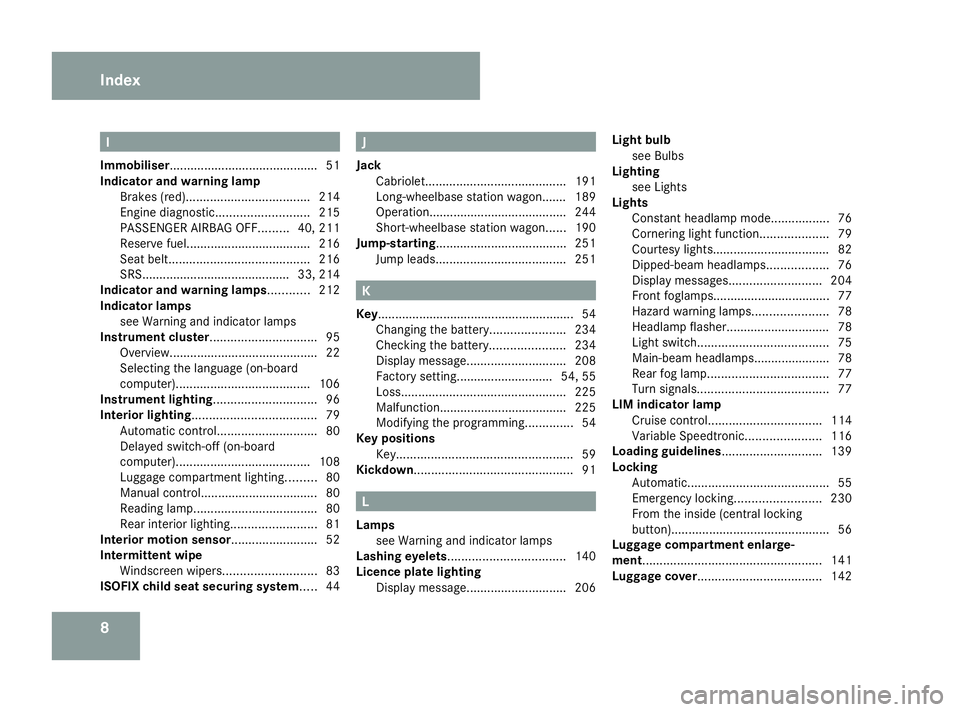
8 I
Immobiliser.......................................... .51
Indicator and warning lamp Brakes (red). ................................... 214
Engine diagnostic ........................... 215
PASSENGER AIRBAG OFF .........40, 211
Reserve fuel. ................................... 216
Seat belt. ........................................ 216
SRS........................................... 33, 214
Indicator and warning lamps............ 212
Indicator lamps see Warning and indicator lamps
Instrument cluster............................... 95
Overview. .......................................... 22
Selecting the language (on-board
computer). ...................................... 106
Instrument lighting.............................. 96
Interior lighting.................................... 79
Automatic control ............................. 80
Delayed switch-off (on-board
computer). ...................................... 108
Luggage compartment lighting. ........80
Manual control.................................. 80
Reading lamp .................................... 80
Rear interior lighting. ........................81
Interior motion sensor......................... 52
Intermittent wipe Windscreen wipers. ..........................83
ISOFIX child seat securing system..... 44 J
Jack Cabriolet. ........................................ 191
Long-wheelbase station wagon....... 189
Operation........................................ 244
Short-wheelbase station wagon. .....190
Jump-starting ...................................... 251
Jump leads ...................................... 251 K
Key......................................................... 54 Changing the battery ......................234
Checking the battery ......................234
Display message ............................. 208
Factory setting............................ 54, 55
Loss. ............................................... 225
Malfunction..................................... 225
Modifying the programming. .............54
Key positions
Key. .................................................. 59
Kickdown.............................................. 91 L
Lamps see Warning and indicator lamps
Lashing eyelets.................................. 140
Licence plate lighting Display message ............................. 206Light bulb
see Bulbs
Lighting
see Lights
Lights
Constant headlamp mode. ................76
Cornering light function ....................79
Courtesy lights.................................. 82
Dipped-beam headlamps ..................76
Display messages ........................... 204
Front foglamps.................................. 77
Hazard warning lamps. .....................78
Headlamp flasher.............................. 78
Light switch. ..................................... 75
Main-beam headlamps..................... .78
Rear fog lamp ................................... 77
Turn signals. ..................................... 77
LIM indicator lamp
Cruise control. ................................ 114
Variable Speedtronic. .....................116
Loading guidelines............................. 139
Locking Automatic. ........................................ 55
Emergency locking .........................230
From the inside (central locking
button) .............................................. 56
Luggage compartment enlarge-
ment.................................................... 141
Luggage cover.................................... 142Index
463_AKB; 1; 8, en-GB
wobuchh,
Version: 2.10.6 2008-07-17T15:19:41+02:00 - Seite 8Dateiname: 6515_4091_02_buchblock.pdf; preflight
Page 13 of 293
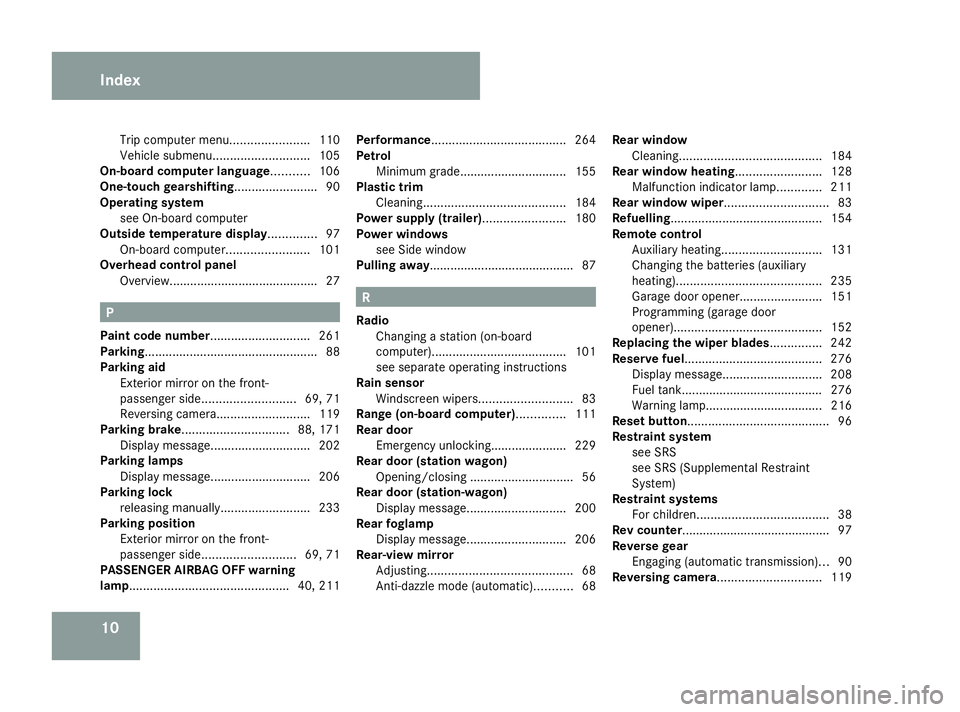
10Trip computer menu.
......................110
Vehicle submenu. ........................... 105
On-board computer language ...........106
One-touch gearshifting........................ 90
Operating system see On-board computer
Outside temperature display.............. 97
On-board computer. .......................101
Overhead control panel
Overview. .......................................... 27P
Paint code number............................. 261
Parking .................................................. 88
Parking aid Exterior mirror on the front-
passenger side. .......................... 69, 71
Reversing camera. ..........................119
Parking brake............................... 88, 171
Display message ............................. 202
Parking lamps
Display message ............................. 206
Parking lock
releasing manually ..........................233
Parking position
Exterior mirror on the front-
passenger side. .......................... 69, 71
PASSENGER AIRBAG OFF warning
lamp.............................................. 40, 211Performance.......................................
264
Petrol Minimum grade............................... 155
Plastic trim
Cleaning. ........................................ 184
Power supply (trailer)........................ 180
Power windows see Side window
Pulling away.......................................... 87 R
Radio Changing a station (on-board
computer). ...................................... 101
see separate operating instructions
Rain sensor
Windscreen wipers. ..........................83
Range (on-board computer).............. 111
Rear door Emergency unlocking...................... 229
Rear door (station wagon)
Opening/closing .............................. 56
Rear door (station-wagon)
Display message ............................. 200
Rear foglamp
Display message ............................. 206
Rear-view mirror
Adjusting .......................................... 68
Anti-dazzle mode (automatic). ..........68Rear window
Cleaning. ........................................ 184
Rear window heating .........................128
Malfunction indicator lamp. ............211
Rear window wiper.............................. 83
Refuelling............................................ 154
Remote control Auxiliary heating ............................. 131
Changing the batteries (auxiliary
heating). ......................................... 235
Garage door opene r........................ 151
Programming (garage door
opener). .......................................... 152
Replacing the wiper blades ...............242
Reserve fuel........................................ 276
Display message ............................. 208
Fuel tank......................................... 276
Warning lamp.................................. 216
Reset button......................................... 96
Restraint system see SRS
see SRS (Supplemental Restraint
System)
Restraint systems
For children. ..................................... 38
Rev counter........................................... 97
Reverse gear
Engaging (automatic transmission) ...90
Reversing camera.............................. 119Index
463_AKB; 1; 8, en-GB
wobuchh,
Version: 2.10.6 2008-07-17T15:19:41+02:00 - Seite 10Dateiname: 6515_4091_02_buchblock.pdf; preflight
Page 16 of 293
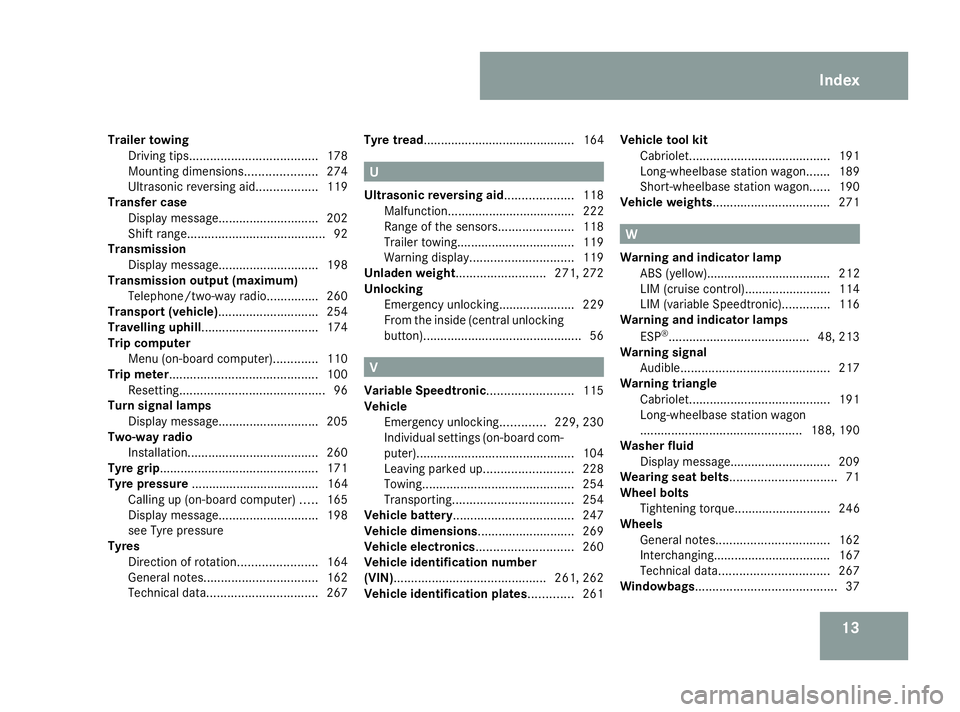
13
Trailer towing
Driving tips. .................................... 178
Mounting dimensions. ....................274
Ultrasonic reversing aid. .................119
Transfer case
Display message ............................. 202
Shift range ........................................ 92
Transmission
Display message ............................. 198
Transmission output (maximum)
Telephone/two-way radio ...............260
Transport (vehicle)............................. 254
Travelling uphill .................................. 174
Trip computer Menu (on-board computer). ............110
Trip meter........................................... 100
Resetting. ......................................... 96
Turn signal lamps
Display message ............................. 205
Two-way radio
Installation. ..................................... 260
Tyre grip.............................................. 171
Tyre pressure ..................................... 164
Calling up (on-board computer) .....165
Display message ............................. 198
see Tyre pressure
Tyres
Direction of rotatio n....................... 164
General notes. ................................ 162
Technical data. ............................... 267Tyre tread............................................ 164 U
Ultrasonic reversing aid.................... 118
Malfunction..................................... 222
Range of the sensors. .....................118
Trailer towing. ................................. 119
Warning displa y.............................. 119
Unladen weight.......................... 271, 272
Unlocking Emergency unlocking...................... 229
From the inside (central unlocking
button) .............................................. 56 V
Variable Speedtronic .........................115
Vehicle Emergency unlocking .............229, 230
Individual settings (on-board com-
puter). ............................................. 104
Leaving parked up. .........................228
Towing. ........................................... 254
Transporting ................................... 254
Vehicle battery................................... 247
Vehicle dimensions............................ 269
Vehicle electronics............................ 260
Vehicle identification number
(VIN)............................................ 261, 262
Vehicle identification plates............. 261Vehicle tool kit
Cabriolet. ........................................ 191
Long-wheelbase station wagon....... 189
Short-wheelbase station wagon. .....190
Vehicle weights.................................. 271 W
Warning and indicator lamp ABS (yellow).................................... 212
LIM (cruise control)......................... 114
LIM (variable Speedtronic). .............116
Warning and indicator lamps
ESP ®
......................................... 48, 213
Warning signal
Audible. .......................................... 217
Warning triangle
Cabriolet. ........................................ 191
Long-wheelbase station wagon
............................................... 188, 190
Washer fluid
Display message ............................. 209
Wearing seat belts............................... 71
Wheel bolts Tightening torque............................ 246
Wheels
General notes. ................................ 162
Interchanging.................................. 167
Technical data. ............................... 267
Windowbags......................................... 37 Index
463_AKB; 1; 8, en-GB
wobuchh,
Version: 2.10.6 2008-07-17T15:19:41+02:00 - Seite 13Dateiname: 6515_4091_02_buchblock.pdf; preflight
Page 28 of 293
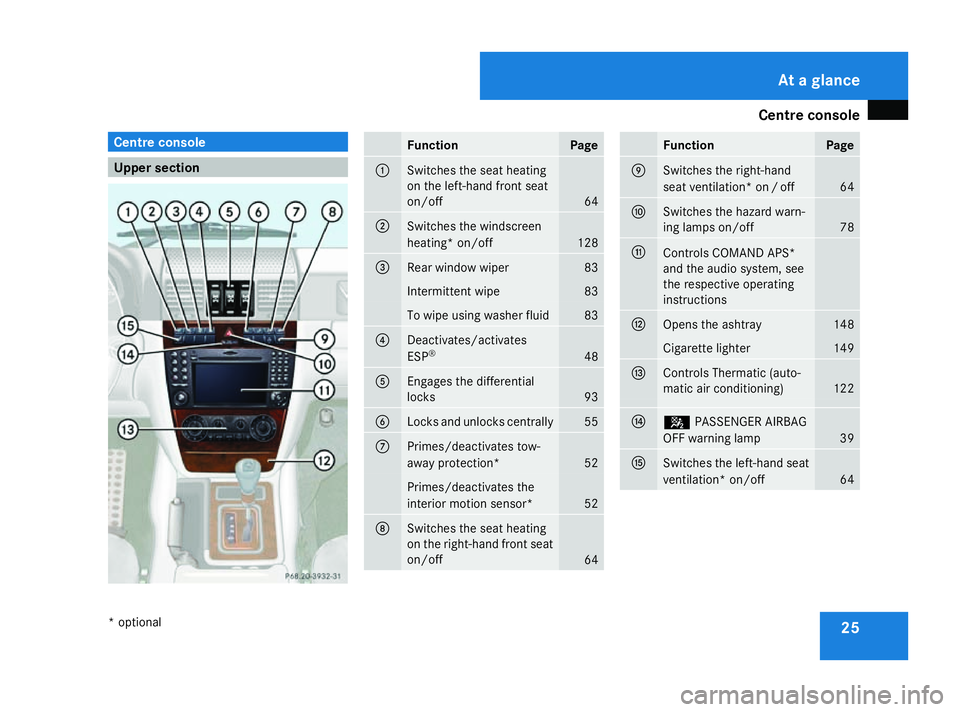
Centre console
25Centre console
Upper section Function Page
1
Switches the seat heating
on the left-hand front seat
on/off 64
2
Switches the windscreen
heating* on/off
128
3
Rear window wiper 83
Intermittent wipe 83
To wipe using washer fluid 83
4
Deactivates/activates
ESP
® 48
5
Engages the differential
locks
93
6
Locks and unlocks centrally 55
7
Primes/deactivates tow-
away protection*
52
Primes/deactivates the
interior motion sensor*
52
8
Switches the seat heating
on the right-hand front seat
on/off
64 Function Page
9
Switches the right-hand
seat ventilation* on
/off 64
a
Switches the hazard warn-
ing lamps on/off
78
b
Controls COMAND APS*
and the audio system, see
the respective operating
instructions
c
Opens the ashtray 148
Cigarette lighter 149
d
Controls Thermatic (auto-
matic air conditioning)
122
J
5
PASSENGER AIRBAG
OFF warning lamp 39
K
Switches the left-hand seat
ventilation* on/off
64At a glance
* optional
463_AKB; 1; 8, en-GB
wobuchh,
Version: 2.10.6 2008-07-17T15:19:41+02:00 - Seite 25Dateiname: 6515_4091_02_buchblock.pdf; preflight
Page 36 of 293
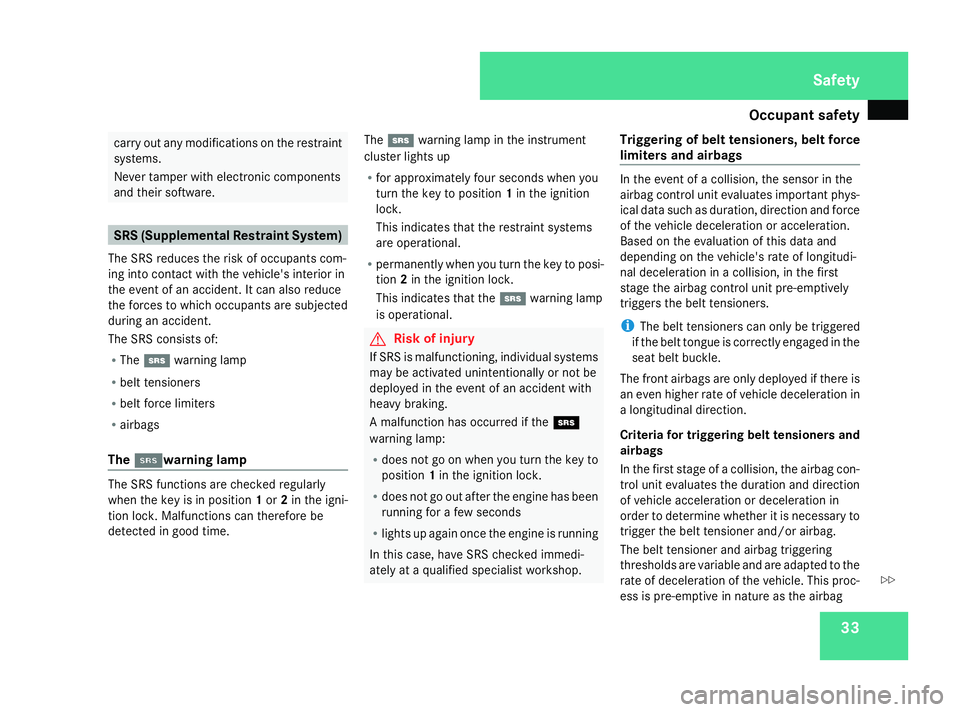
Occupant safety
33carry out any modifications on the restraint
systems.
Never tamper with electronic components
and their software.
SRS (Supplemental Restraint System)
The SRS reduces the risk of occupants com-
ing into contact with the vehicle's interior in
the event of an accident. It can also reduce
the forces to which occupants are subjected
during an accident.
The SRS consists of:
R The 1 warning lamp
R belt tensioners
R belt force limiters
R airbags
The 1 1warning lamp The SRS functions are checked regularly
when the key is in position
1or 2in the igni-
tion lock. Malfunctions can therefore be
detected in good time. The
1 warning lamp in the instrument
cluster lights up
R for approximately four seconds when you
turn the key to position 1in the ignition
lock.
This indicates that the restraint systems
are operational.
R permanently when you turn the key to posi-
tion 2in the ignition lock.
This indicates that the 1warning lamp
is operational. G
Risk of injury
If SRS is malfunctioning, individual systems
may be activated unintentionally or not be
deployed in the event of an accident with
heavy braking.
A malfunction has occurred if the 1
warning lamp:
R does not go on when you turn the key to
position 1in the ignition lock.
R does not go out after the engine has been
running for a few seconds
R lights up again once the engine is running
In this case, have SRS checked immedi-
ately at a qualified specialist workshop. Triggering of belt tensioners, belt force
limiters and airbags In the event of a collision, the sensor in the
airbag control unit evaluates important phys-
ical data such as duration, direction and force
of the vehicle deceleration or acceleration.
Based on the evaluation of this data and
depending on the vehicle's rate of longitudi-
nal deceleration in a collision, in the first
stage the airbag control unit pre-emptively
triggers the belt tensioners.
i The belt tensioners can only be triggered
if the belt tongue is correctly engaged in the
seat belt buckle.
The front airbags are only deployed if there is
an even higher rate of vehicle deceleration in
a longitudinal direction.
Criteria for triggering belt tensioners and
airbags
In the first stage of a collision, the airbag con-
trol unit evaluates the duration and direction
of vehicle acceleration or deceleration in
order to determine whether it is necessary to
trigger the belt tensioner and/or airbag.
The belt tensioner and airbag triggering
thresholds are variable and are adapted to the
rate of deceleration of the vehicle. This proc-
ess is pre-emptive in nature as the airbag Safety
463_AKB; 1; 8, en-GB
wobuchh,
Version: 2.10.6 2008-07-17T15:19:41+02:00 - Seite 33 ZDateiname: 6515_4091_02_buchblock.pdf; preflight
Page 37 of 293
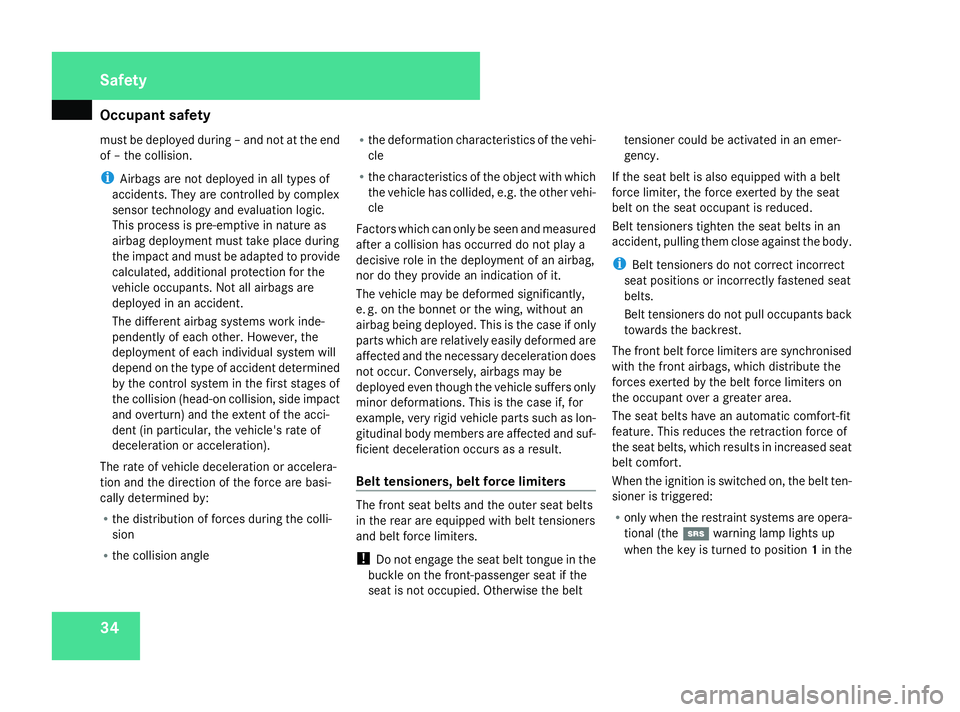
Occupant safety
34
must be deployed during – and not at the end
of – the collision.
i Airbags are not deployed in all types of
accidents. They are controlled by complex
sensor technology and evaluation logic.
This process is pre-emptive in nature as
airbag deployment must take place during
the impact and must be adapted to provide
calculated, additional protection for the
vehicle occupants. Not all airbags are
deployed in an accident.
The different airbag systems work inde-
pendently of each other. However, the
deployment of each individual system will
depend on the type of accident determined
by the control system in the first stages of
the collision (head-on collision, side impact
and overturn) and the extent of the acci-
dent (in particular, the vehicle's rate of
deceleration or acceleration).
The rate of vehicle deceleration or accelera-
tion and the direction of the force are basi-
cally determined by:
R the distribution of forces during the colli-
sion
R the collision angle R
the deformation characteristics of the vehi-
cle
R the characteristics of the object with which
the vehicle has collided, e.g. the other vehi-
cle
Factors which can only be seen and measured
after a collision has occurred do not play a
decisive role in the deployment of an airbag,
nor do they provide an indication of it.
The vehicle may be deformed significantly,
e. g. on the bonnet or the wing, without an
airbag being deployed. This is the case if only
parts which are relatively easily deformed are
affected and the necessary deceleration does
not occur. Conversely, airbags may be
deployed even though the vehicle suffers only
minor deformations. This is the case if, for
example, very rigid vehicle parts such as lon-
gitudinal body members are affected and suf-
ficient deceleration occurs as a result.
Belt tensioners, belt force limiters The front seat belts and the outer seat belts
in the rear are equipped with belt tensioners
and belt force limiters.
!
Do not engage the seat belt tongue in the
buckle on the front-passenger seat if the
seat is not occupied. Otherwise the belt tensioner could be activated in an emer-
gency.
If the seat belt is also equipped with a belt
force limiter, the force exerted by the seat
belt on the seat occupant is reduced.
Belt tensioners tighten the seat belts in an
accident, pulling them close against the body.
i Belt tensioners do not correct incorrect
seat positions or incorrectly fastened seat
belts.
Belt tensioners do not pull occupants back
towards the backrest.
The front belt force limiters are synchronised
with the front airbags, which distribute the
forces exerted by the belt force limiters on
the occupant over a greater area.
The seat belts have an automatic comfort-fit
feature. This reduces the retraction force of
the seat belts, which results in increased seat
belt comfort.
When the ignition is switched on, the belt ten-
sioner is triggered:
R only when the restraint systems are opera-
tional (the 1warning lamp lights up
when the key is turned to position 1in the Safety
463_AKB; 1; 8, en-GB
wobuchh,
Version: 2.10.6 2008-07-17T15:19:41+02:00 - Seite 34Dateiname: 6515_4091_02_buchblock.pdf; preflight
Page 43 of 293
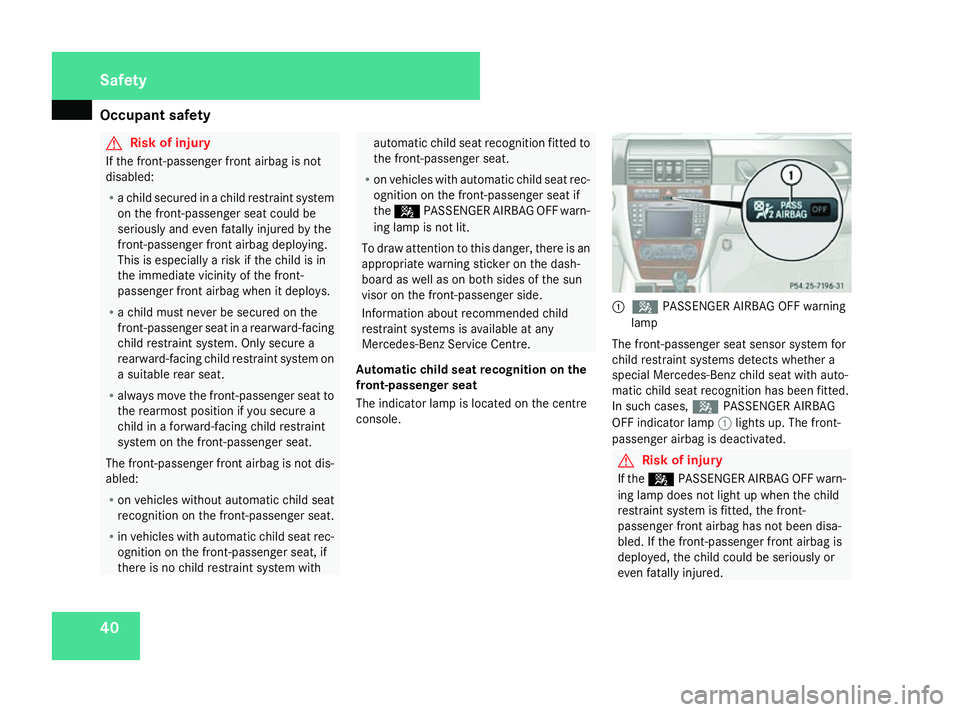
Occupant safety
40 G
Risk of injury
If the front-passenger front airbag is not
disabled:
R a child secured in a child restraint system
on the front-passenger seat could be
seriously and even fatally injured by the
front-passenger front airbag deploying.
This is especially a risk if the child is in
the immediate vicinity of the front-
passenger front airbag when it deploys.
R a child must never be secured on the
front-passenger seat in a rearward-facing
child restraint system. Only secure a
rearward-facing child restraint system on
a suitable rear seat.
R always move the front-passenger seat to
the rearmost position if you secure a
child in a forward-facing child restraint
system on the front-passenger seat.
The front-passenger front airbag is not dis-
abled:
R on vehicles without automatic child seat
recognition on the front-passenger seat.
R in vehicles with automatic child seat rec-
ognition on the front-passenger seat, if
there is no child restraint system with automatic child seat recognition fitted to
the front-passenger seat.
R on vehicles with automatic child seat rec-
ognition on the front-passenger seat if
the 5 PASSENGER AIRBAG OFF warn-
ing lamp is not lit.
To draw attention to this danger, there is an
appropriate warning sticker on the dash-
board as well as on both sides of the sun
visor on the front-passenger side.
Information about recommended child
restraint systems is available at any
Mercedes-Benz Service Centre.
Automatic child seat recognition on the
front-passenger seat
The indicator lamp is located on the centre
console. 1
5 PASSENGER AIRBAG OFF warning
lamp
The front-passenger seat sensor system for
child restraint systems detects whether a
special Mercedes-Benz child seat with auto-
matic child seat recognition has been fitted.
In such cases, 5PASSENGER AIRBAG
OFF indicator lamp 1lights up. The front-
passenger airbag is deactivated. G
Risk of injury
If the 5 PASSENGER AIRBAG OFF warn-
ing lamp does not light up when the child
restraint system is fitted, the front-
passenger front airbag has not been disa-
bled. If the front-passenger front airbag is
deployed, the child could be seriously or
even fatally injured. Safety
463_AKB; 1; 8, en-GB
wobuchh,
Version: 2.10.6 2008-07-17T15:19:41+02:00 - Seite 40Dateiname: 6515_4091_02_buchblock.pdf; preflight
Page 44 of 293
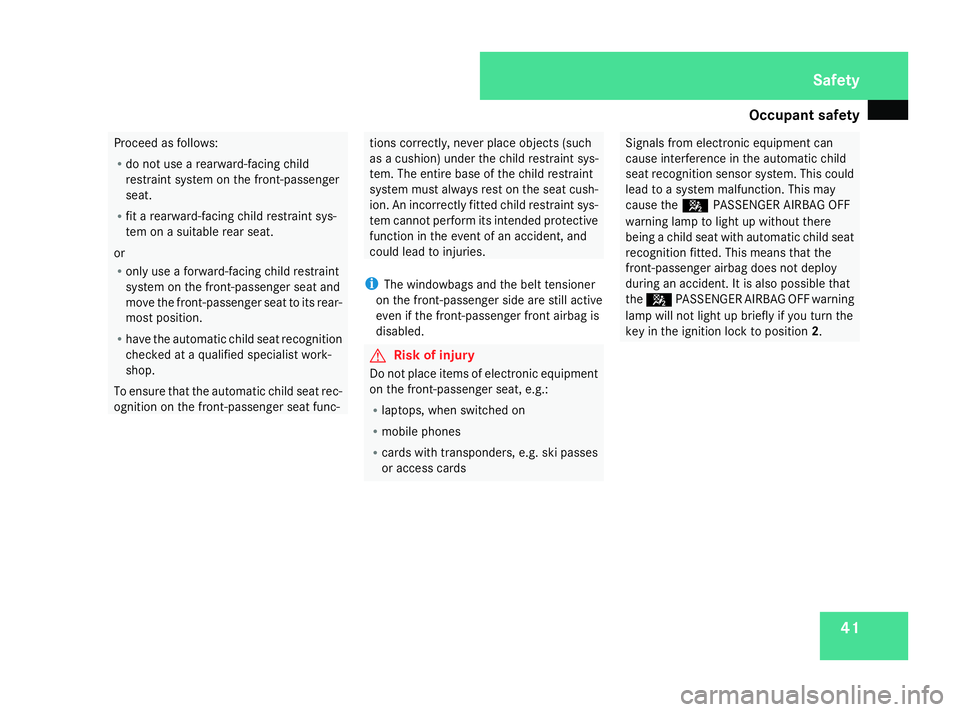
Occupant safety
41Proceed as follows:
R
do not use a rearward-facing child
restraint system on the front-passenger
seat.
R fit a rearward-facing child restraint sys-
tem on a suitable rear seat.
or
R only use a forward-facing child restraint
system on the front-passenger seat and
move the front-passenger seat to its rear-
most position.
R have the automatic child seat recognition
checked at a qualified specialist work-
shop.
To ensure that the automatic child seat rec-
ognition on the front-passenger seat func- tions correctly, never place objects (such
as a cushion) under the child restraint sys-
tem. The entire base of the child restraint
system must always rest on the seat cush-
ion. An incorrectly fitted child restraint sys-
tem cannot perform its intended protective
function in the event of an accident, and
could lead to injuries.
i The windowbags and the belt tensioner
on the front-passenger side are still active
even if the front-passenger front airbag is
disabled. G
Risk of injury
Do not place items of electronic equipment
on the front-passenger seat, e.g.:
R laptops, when switched on
R mobile phones
R cards with transponders, e.g. ski passes
or access cards Signals from electronic equipment can
cause interference in the automatic child
seat recognition sensor system. This could
lead to a system malfunction. This may
cause the
5PASSENGER AIRBAG OFF
warning lamp to light up without there
being a child seat with automatic child seat
recognition fitted. This means that the
front-passenger airbag does not deploy
during an accident. It is also possible that
the 5 PASSENGER AIRBAG OFF warning
lamp will not light up briefly if you turn the
key in the ignition lock to position 2. Safety
463_AKB; 1; 8, en-GB
wobuchh,
Version: 2.10.6 2008-07-17T15:19:41+02:00 - Seite 41 ZDateiname: 6515_4091_02_buchblock.pdf; preflight
Page 55 of 293
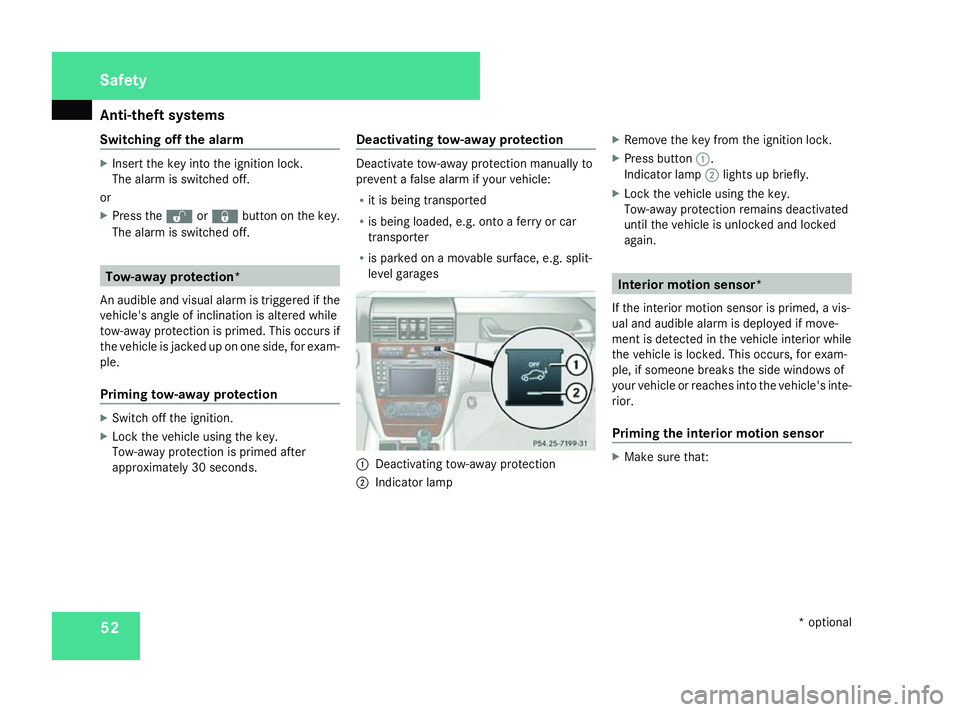
Anti-theft syste
ms52
Switching off the alarm X
Insert the key into the ignition lock.
The alarm is switched off.
or
X Press the Œor‹ button on the key.
The alarm is switched off. Tow-away protection*
An audible and visual alarm is triggered if the
vehicle's angle of inclination is altered while
tow-away protection is primed. This occurs if
the vehicle is jacked up on one side, for exam-
ple.
Priming tow-away protection X
Switch off the ignition.
X Lock the vehicle using the key.
Tow-away protection is primed after
approximately 30 seconds. Deactivating tow-away protection Deactivate tow-away protection manually to
prevent a false alarm if your vehicle:
R
it is being transported
R is being loaded, e.g. onto a ferry or car
transporter
R is parked on a movable surface, e.g. split-
level garages 1
Deactivating tow-away protection
2 Indicator lamp X
Remove the key from the ignition lock.
X Press button 1.
Indicator lamp 2lights up briefly.
X Lock the vehicle using the key.
Tow-away protection remains deactivated
until the vehicle is unlocked and locked
again. Interior motion sensor*
If the interior motion sensor is primed, a vis-
ual and audible alarm is deployed if move-
ment is detected in the vehicle interior while
the vehicle is locked. This occurs, for exam-
ple, if someone breaks the side windows of
your vehicle or reaches into the vehicle's inte-
rior.
Priming the interior motion sensor X
Make sure that: Safety
* optional
463_AKB; 1; 8, en-GB
wobuchh
,V ersion: 2.10.6
2008-07-17T15:19:41+02:00 - Seite 52 Dateiname: 6515_4091_02_buchblock.pdf; preflight
Page 56 of 293
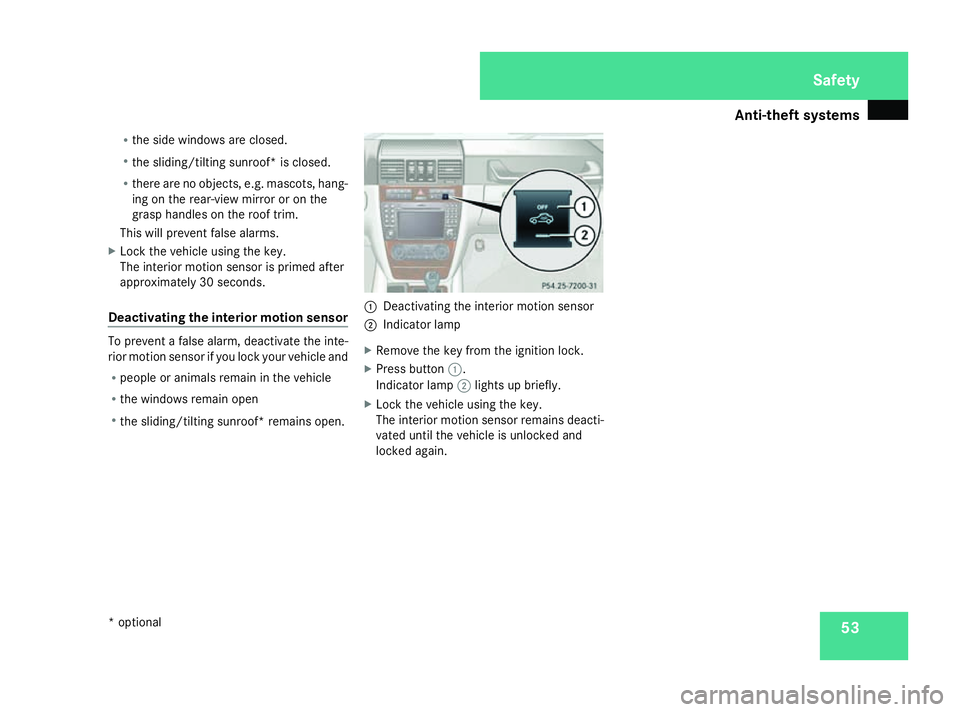
Anti-theft syste
ms 53
R
the side windows are closed.
R the sliding/tilting sunroof* is closed.
R there are no objects, e.g. mascots, hang-
ing on the rear-view mirror or on the
grasp handles on the roof trim.
This will prevent false alarms.
X Lock the vehicle using the key.
The interior motion sensor is primed after
approximately 30 seconds.
Deactivating the interior motion sensor To prevent a false alarm, deactivate the inte-
rior motion sensor if you lock your vehicle and
R
people or animals remain in the vehicle
R the windows remain open
R the sliding/tilting sunroof* remains open. 1
Deactivating the interior motion sensor
2 Indicator lamp
X Remove the key from the ignition lock.
X Press button 1.
Indicator lamp 2lights up briefly.
X Lock the vehicle using the key.
The interior motion sensor remains deacti-
vated until the vehicle is unlocked and
locked again. Safety
* optional
463_AKB; 1; 8, en-GB
wobuchh
,V ersion: 2.10.6
2008-07-17T15:19:41+02:00 - Seite 53 ZDateiname: 6515_4091_02_buchblock.pdf; preflight